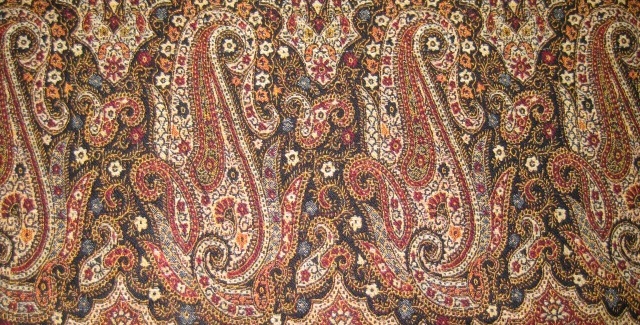Exhibition
13 December 2011 – 14 January 2012
An Exhibition of Kashmir Shawls
The Kashmir shawl has been characterized by the boteh (or buta, meaning flower), the principal motif with which the shawl is associated. This repetitive curvilinear shape has been known by many names since its first appearance on shawls in the eighteenth century – most famously called paisley. The development of the Kashmir shawl is closely related to the development of the boteh motif; the motif’s different forms express different periods in the shawl’s development. It began in the Moghul period as the flowering plant and by the middle of the nineteenth century it had developed into an extremely stylized form of sweeping sinuous curves far removed from any resemblance of nature’s flora.
Shawls have been woven in Kashmir since about the eleventh century, but the industry producing what we refer to as a Kashmir shawl is thought to have begun during the fifteenth and sixteenth centuries. During the fifteenth century Persian replaced Sanskrit as the official language and the world ‘shawl’ derives from the Persian shal, denoting a class of woven fabric rather than an article of dress. During its history Kashmir experienced Moghul, Afghan and Sikh invasions, all of which left their stylistic influence on the shawl.
The Moghuls conquered Kashmir in 1586. Under their rule the arts blossomed and the shawl industry grew. Weavers were brought in from Eastern Turkestan where the type of weave later used for Kashmir shawls was practiced. Persian men had traditionally worn narrow waist girdles of shawl fabric, as part of male dress, while the Indians wove wide shoulder mantles for male attire. These were usually given as prestigious gifts, and one can clearly see the honor in which they were held by looking at miniatures of the period, where the proud owner is seen wearing such an accessory.
From about 1775 Kashmir shawls were acquired by travelers, explorers, military personnel and members of the East India Company who, appreciating their beauty and warmth, brought them back as presents. A Kashmir shawl in 1797 would cost 50 guineas (£50/ $100), a huge sum. Following Napoleon’s 1798-99 campaign in Egypt. French officers returned laden with shawls as gifts. Empress Josephine owned several hundred shawls, some of which had cost as much as 12,000 francs, an exorbitant price at the time.


